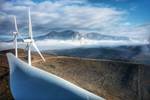Vestas selected as preferred supplier for 1.3 GW MunmuBaram floating offshore wind project
Announcement marks the first large-scale floating offshore project for Vestas, and first V236-15.0 MW installation on floating foundations.

Photo Credit: Vestas
With the introduction of the V236-15.0 megawatt (MW) wind turbine —featuring 115.5-meter-long composite blades — Vestas (Aarhus, Denmark) reports that it is playing a leading role in the expansion of offshore wind. The company has been recently named the preferred turbine supplier by MunmuBaram, a joint venture between Shell (London, U.K.) and Hexicon AB (Stockholm, Sweden), for the 1.3 GW MunmuBaram floating offshore wind project located off the southeast coast of South Korea.
If the project goes forward, Vestas will supply and install 84 V236-15.0 MW turbine units. The wind turbines will be installed on floating foundations in the 240-square-kilometer project area, with water depths ranging between 120 and 150 meters. This will mark the first announced large-scale floating offshore project for Vestas, and the first announced project of V236-15.0 MW for installation on floating foundations.
“We are excited to engage in this innovative project that spearheads the global offshore wind industry and underlines our ambition to partner with customers and suppliers to make floating offshore wind energy profitable, scalable and serviceable,” Purvin Patel, president of Vestas Asia Pacific, says.
In many countries, especially the Asia Pacific region, floating wind is considered a crucial driver to achieve renewable energy goals. This is primarily because of regional geographic characteristics and weather conditions, such as deep coastal waters and frequent earthquakes and typhoons, which don’t favor offshore wind turbines on conventional bottom-fixed foundations.
“Large-scale turbines will make floating offshore wind projects more economically feasible by improving the yields. For stable operation of large-scale turbines, the integration with floating foundations (floaters) is essential,” YoungKyu Ju, the project director of MunmuBaram, emphasizes. “This agreement will help develop a competitive floating offshore wind business model by optimizing Vestas’ 15MW turbines with locally produced floaters.”
With this project, MunmuBaram and Vestas are taking a leading role in South Korea’s offshore wind industry development and bringing the country one step closer to achieving its net-zero emissions goal.
Once installed, Vestas will also deliver 20-year service and maintenance for the wind farm. Through the establishment of dedicated local service organization, Vestas will contribute to local job creation and provide high-level training for offshore service technicians.
Vestas has installed more than 8 GW or more than 1,500 offshore turbines globally. The company has also installed turbines on floating foundations for more than a decade, including projects off the coasts of Scotland and Portugal. The MunmuBaram project is Vestas’ third partnership with Shell, following to the 730 MW Borssele III/IV offshore wind project in the Netherlands, and the Atlantic Shores’ 1.5 gigawatt (GW) offshore wind project in the U.S. which will also feature V236-15.0 MW turbines.
Related Content
-
MingYang reveals 18-MW offshore wind turbine model with 140-meter-long blades
The Chinese wind turbine manufacturer surpasses its 16-MW platform, optimizes wind farm construction costs for 1-GW wind farms.
-
Polar Technology develops innovative solutions for hydrogen storage
Conformable “Hydrogen in a Box” prototype for compressed gas storage has been tested to 350 and 700 bar, liquid hydrogen storage is being evaluated.
-
Novel composite technology replaces welded joints in tubular structures
The Tree Composites TC-joint replaces traditional welding in jacket foundations for offshore wind turbine generator applications, advancing the world’s quest for fast, sustainable energy deployment.












.jpg;maxWidth=300;quality=90)


